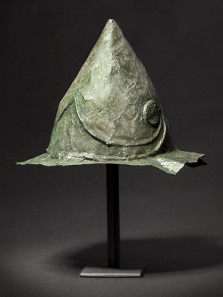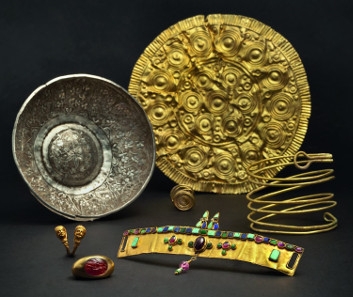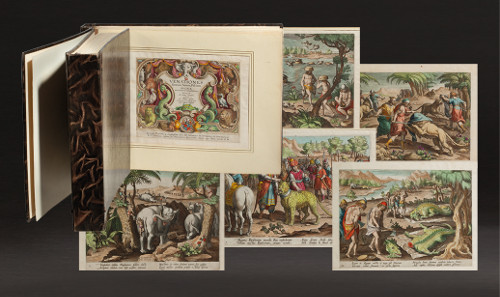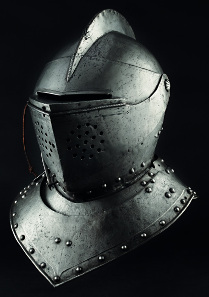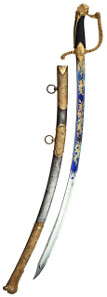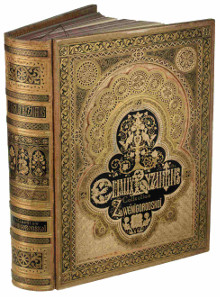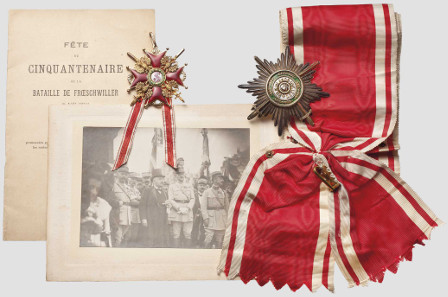27-04-2015 – 11-05-2015
Spring Auction
Spring Auction of Hermann Historica in Munich
This year’s Spring Auction at Hermann Historica will take place from 28 April to 12 May. Approximately 6,000 lots from all specialist areas represented by the auction house are to come under the hammer – antiquities, arms and armour, works of art, hunting antiques, orders and collectibles from all fields of history and military history.
3532: A Hellenistic helmet of Pilos type with offset brim and brow element, 2nd – early 1st century BC. Estimate: 23,000 euro.
Antiquities
Once again, the antiquities section offers several veritable rarities among the early bronze helmets, including an extremely unusual Hellenistic helmet type, a Pilos helmet with its wide brim and offset brow element, dating from the 2nd to the early 1st century B.C. Standing 22 cm tall and tapering to a point, the skull of the helmet has perforations for the original leather straps; its shape is familiar from various contemporary depictions on coins and reliefs. A helmet of this type was last offered for sale in the art trade in 2004. By contrast, the appeal of this example lies not merely in its rarity but in its complete and unmodified state of preservation, which is reflected in the starting price of 23,000 euros. In no less outstanding condition and dating from the same period, during the Augustan Age, is a bronze Roman helmet of the Hagenau type. With its characteristic mushroom-shaped finial and the neck guard sloping slightly downwards, the hemispherical skull has been hammered from a single sheet; particularly striking is the excellent condition of the metal substance. Bids are invited from 25,000 euros for the helmet, which would grace even the most prestigious collection. Moreover, two antique sculptures are being offered for sale with a reserve of 20,000 euros each. While the Roman marble sculpture, dating from the first to second century A.D., is an exquisitely carved torso of a young boy, his hair falling in soft curls, the diminutive Hellenistic bronze sculpture, standing a mere 10.7 centimetres tall, is an extraordinarily expressive, even grotesque, representation of a crippled artiste with a hunchback and misshapen chest, his suffering clearly evident in his cadaverous countenance.
A variety of exquisitely worked objects that were crafted by gold and silversmiths in ancient times, originating from the 15th century B.C.to the 15th century A.C.
The auction again includes a variety of delightful, exquisitely worked objects that were crafted by gold and silversmiths in ancient times, like the jewellery fashioned in the legendary gold of Bactria. Open to bids from 10,000 euros, the distinctive set comprises a gold diadem and two earrings, inlaid with pearls and partly engraved gemstones, and dates from the time of the Kushan Empire, which held sway during the first three centuries A.D. Originating in the 15th to the 14th century B.C. are four embellished discs of sheet gold. Decorated with complex ornamentation and frequently interpreted as sun symbols, they are comparable to the ‘Moordorf solar disc’. The remarkably well preserved set of Bronze Age cult objects is listed at 7,500 euros.
Arms and armour, arts and crafts
According to tradition, the arms and armour catalogue opens with hunting antiques, works of art and rare wunderkammer objects.
2031: Johannes Stradanus “Venationes Ferarum, Avium, Piscium…”, Antwerp, 1578-96 and later. Estimate: 10,000 euro.
The highly talented Johannes Stradanus, born Jan van der Straet in Bruges in 1523, travelled to Italy for the first time in 1545 where he created some of the most magnificent hunting scenes of the Renaissance. He was commissioned by Cosimo I de’ Medici (1519 – 1574) to prepare a series of designs for hunting tapestries. These engravings subsequently formed the basis for his unique work, his “Venationes Ferarum”, a collection of 104 plates, 62 of which were coloured by hand, featuring a detailed representation of the hunt on a variety of animals, including exotic beasts and mythical creatures. Now, in the Spring Auction, an almost complete collection of this fabulous work, including the two title pages and 99 of the engravings, whose creator died in Florence in 1605, is to come under the hammer for 10,000 euros. Collectors will also be interested in a beautiful, Gothic leather-covered casket, which was crafted in Upper Austria during the 15th century and estimated at 3,500 euros, a pair of exceptionally rare, large pewter tankards of the boatswains’ guild in Rostock, dated 1793 and valued at 2,800 euros, as well as a heavy, red uniform cloak, known as a roquelaure, from the late 17th century, which may be acquired from 1,500 euros. The list continues with walking sticks made of rhinoceros horn from 350 euros, and an English drinking cup in the same material starting at 2,500 euros; finally, a collection of ornate thimbles and a large selection of locks and keys round off the lots in this section.
Once more, exceptional collectors’ items are among the antique arms and armour on offer. One highlight is a striking, Maximilian close helmet for a fluted suit of armour, which was forged in South Germany circa 1530. Wrought in one piece and still retaining the original leather lining, the skull features the characteristic, flat flutes of this type extending from front to back. The large, matching gorget, also fluted, slides on three lames and is embellished with turned and finely roped flanges. Documented for the collection of the retired Consul Hans C. Leiden in Cologne since 1934, this magnificent example of early armourer’s artistry will doubtless take pride of place in a new collection from 30,000 euros.
3146: A South German tournament helmet, probably Augsburg, circa 1580. Estimate: 12,000 euro.
Equally fascinating and opening at 12,000 euros is a South German tournament helmet, dating from 1580, that was probably manufactured in Augsburg. Forged in one piece with a tall, roped comb, the helmet is extremely heavy by reason of its function and is fitted with both a protective bevor and a pivoted visor. The marks of numerous sword blows are evidence that the early modern helmet actually proved its worth in tournaments. The impressive appearance of a German light cavalry armour, circa 1550/1570 will surely delight buyers. Sliding on multiple lames to ensure maximum mobility in the joints, the suit of armour is complete in all parts, including the heavy combat burgonet with its high roped comb and the rare adjustable nasal bar, and is now open to bids from 9,000 euros.
Asia, Orient and Africa
The quality and diversity of the lots from Africa, the Ottoman Empire, India, Japan and China remain as compelling as ever. Also up for auction are some extremely rare objects from the slopes of the Himalayas.
2743: A Tibetan vajra hammer with gold and silver inlays, 15th century. Estimate: 9,000 euro.
An example of superlative chiselling craftsmanship, a 15th century Tibetan vajra hammer, its handle profusely embellished with gold and silver inlays, with a half vajra and chiselled makara heads, is offered for sale from 9,000 euros. A second, identically crafted vajra from the same period and region has a limit of 4,000 euros. Fascinating objects from China include delicate jade carvings. In particular, two late 19th century lidded vessels, valued at 8,000 euros and 4,000 euros respectively, have been fashioned with masterly craftsmanship. While both the lid and body of the bijou in white jade are richly decorated in relief, the lid crowned with a carving of a foo dog, the bellied vessel of light green jade stands on three lion feet and a figural dragon finial serves as a handle on the lid.
Military history and historical objects
An example from the turbulent history of Mexico during the 19th century is the silver laurel wreath designed as a symbol of the presidential dignity of José de la Cruz Porfirio Diaz Mori (1830 – 1915), who ruled the country intermittently from 1876 until 1911. While his opponents adopted a silver laurel wreath during their term in office, Diaz insisted on a wreath that surpassed all others, decorated with Mexican symbols like the gilt eagle with the serpent and jewels in the Mexican national colours. The unique signet of power is offered for auction from 12,000 euros.
4759: A magnificent Royal Bavarian presentation sabre, awarded for bravery, dating from the reign of Maximilian I Joseph (1806-1825). Estimate: 15,000 euro.
Of German provenance, a magnificent Royal Bavarian presentation sabre, awarded for bravery, is particularly imposing; dating from the reign of Maximilian I Joseph (1806 – 1825), the sabre was produced in Solingen and is etched on both sides with gilt foliage and trophies against a blued background. The gilt brass knuckle-bow hilt is richly decorated in relief with a Medusa’s head and foliage, while the quillons is adorned with the profile of Maximilian I Joseph of Bavaria between laurel branches and the crowned Bavarian lion bearing a sword and escutcheon. Exceptionally high-quality insignia of this type were reserved for the rank of general. Undoubtedly of museum quality, the sabre is listed at 15,000 euros. Also for sale is a portfolio from the personal property of King Ludwig II of Bavaria (1845 – 1886), the fine reddish brown leather embossed with the characteristic crowned gold cipher “L”, which may be acquired from 3,000 euros.
4648: A deluxe edition of “History and Monuments of Byzantine Enamels”, Nikodim Pavlovich Kondakov (1844-1925), dated 1892. Estimate: 11,000 euro.
One of the greatest bibliographic rarities and, without a doubt, a masterpiece of the Russian art of book printing: a deluxe edition of ‘History and Monuments of Byzantine Enamels’, penned by the historian and archeologist Nikodim Pavlovich Kondakov (1844 – 1925) is now being offered for sale to international collectors, with bids opening at 11,000 euros. For the prodigious expense of 120,000 roubles in gold, an enormous sum back in 1892, a mere 600 copies were produced, of which 200 were printed in French, including illustrations by the most outstanding graphic artists of the time and a dedication to Tsar Alexander III. The leather bindings are decorated with fine embossing in gold and contain 388 inner pages in colour, of which 31 are chromo-lithographed plates. The illustrations of the enamels were painted by the best graphic artists in St. Petersburg under the direction of the engraver V. V. Mate. Ultimately, the bookmark in gold and silver thread, produced by the Sapozhnikov factory in Moscow, the reproduction of the illustrations in chromo-lithography by August Osterrieth in Frankfurt and the thick paper made in Strasbourg all serve to accentuate the tremendous significance of this bibliophile masterpiece.
Orders and Insignia
Once again, the Spring Auction 2015 holds phaleristic sensations in store. The estate of the Imperial Prussian Admiral Hermann Jacobsen, including a particularly rare Russian Order of St. Stanislaus 2nd Class with breast star, is to come under the hammer for 7,000 euros. Bids are invited from 5,000 euros for the Grand Cross with Swords of Baden’s Order of the Zähringer Lion and, among the orders of Hesse-Kassel, the 1769 Order pour la Vertu Militaire, of museum quality and estimated at 10,000 euros, is sure to delight collectors. Only one other order cross in this condition is known to exist, namely in the State Hermitage Museum in Lenningrad.
4054: Order of St. Stanislaus – a set of the 1st Class with Swords, Russia, circa 1910. Estimate: 14,000 euro.
One of the highlights of the orders section is a set of the 1st Class with Swords of the Order of St. Stanislaus from the Russian tsarist empire, circa 1910, worked in gold, silver and enamel, which is valued at 14,000 euros. Now open to bids from 12,000 euros is one of the highest German orders of bravery, the Commander’s Cross in the World War issue of the Karl Friedrich Military Merit Order – a rarity since a total of only ten such awards are documented during the World War.
You may find all lots of the sale online on the website of Hermann Historica.



